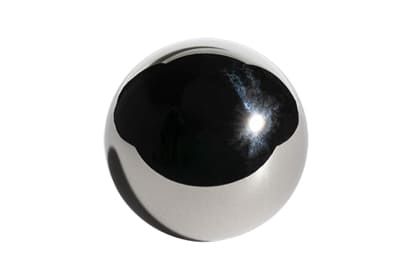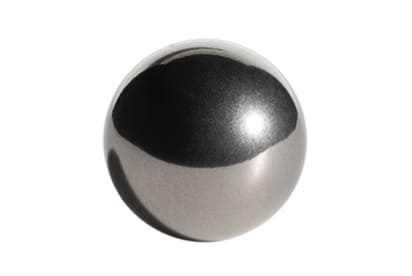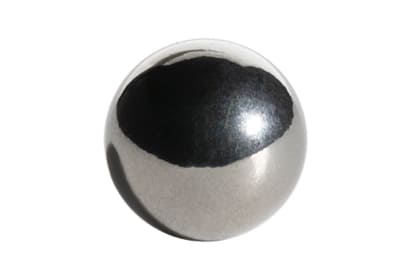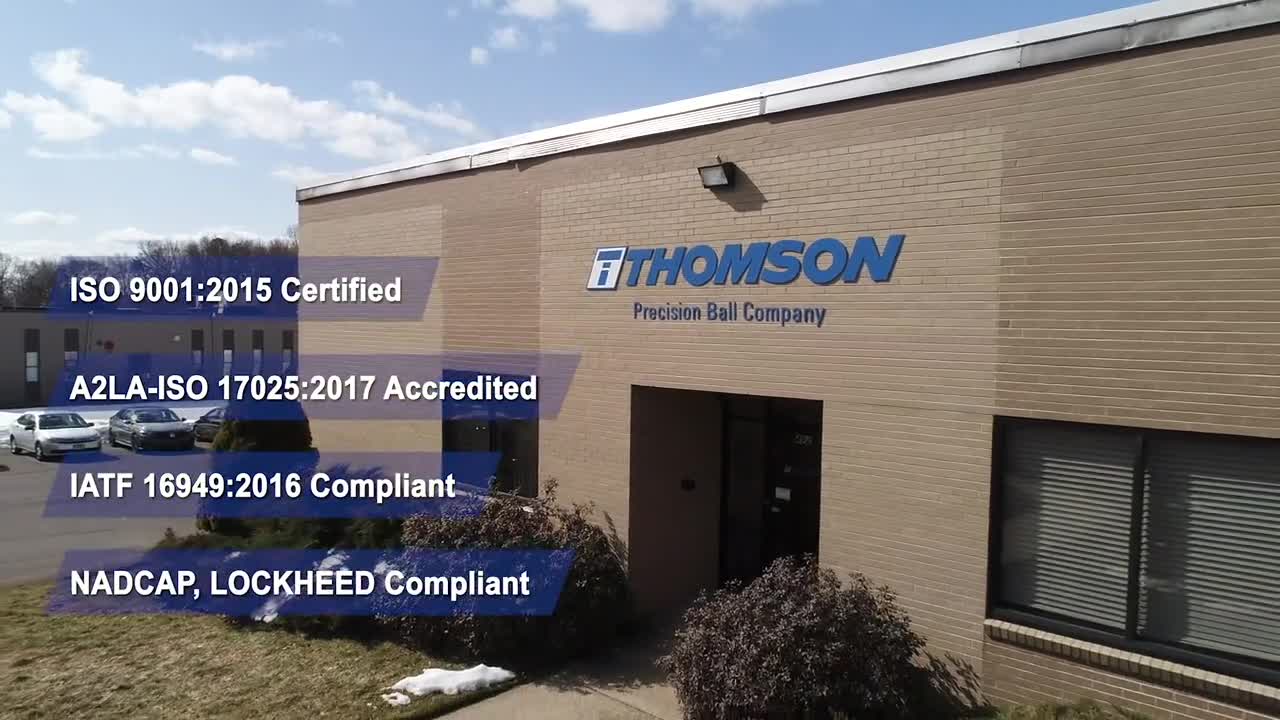Choose Your Login Account
Thomson currently has two account systems - one for the website and CAD model downloads, and one for e-commerce. We understand that two logins is an inconvenience and are working to consolidate our systems into one login process. Until we’re able to consolidate the two logins, please follow these guidelines:
- Download CAD models
- Save and retrieve projects in LinearMotioneering® and MicronMotioneering® tools
- Access Distributor Extranet and all related resources
- Order directly from Thomson online (North America only)
- Authorized Thomson Distributors can view and order from quotes online (Global)
- View the shopping cart and look up prior direct orders
Seleccione el tipo de producto

Cromo 52100
También conocido como acero al cromo, el 52100 es un material extremadamente duro y resistente al desgaste con alta capacidad de carga.

Acero inoxidable duro
Serie 400 (inoxidable duro) El acero inoxidable Serie 400 es uno de los tipos más duros de acero después del tratamiento térmico. Tiene propiedades magnéticas.

Acero inoxidable blando
El acero inoxidable Serie 300 es una buena opción integral para una gran variedad de aplicaciones. Es resistente a la corrosión en altas temperaturas y tiene valores prácticamente no magnéticos.

Cerámica
Para altas temperaturas o aplicaciones en las que se necesita peso y rigidez. Coeficiente más bajo de expansión térmica.

E52100
E52100 - También conocido como acero al cromo, el 52100 es un material extremadamente duro y resistente al desgaste con alta capacidad de carga.

HCC DFARS
HCC DFARS - El acero al cromo con certificado de cumplimiento del DFARS está diseñado para aplicaciones aeroespaciales.

HCC Fundido al vacío
HCC Fundido al vacío - Acero al cromo con procesamiento avanzado de metal a fin de garantizar que el material mantenga su pureza durante la fundición.

440C
440C - Los aceros 440 son los más duros de todos los aceros inoxidables, y esto los convierte en resistentes tanto a la abrasión como a la corrosión.

440C DFARS
440C DFARS - Acero similar al 440C que cumple con el DFARS y está diseñado para aplicaciones aeroespaciales.

440C Fundido al vacío
440C Fundido al vacío - Material 440C con procesamiento avanzado de metal a fin de garantizar que el material mantenga su pureza durante la fundición.

440A
440A - Acero inoxidable tipo 440A con propiedades físicas similares al 440C con menor nivel de carbono para mayor funcionamiento.

420C
420C - Como las propiedades del acero inoxidable 420C hacen que sea un material duradero en diferentes ambientes, es una de las opciones más versátiles para una gran variedad de aplicaciones.

BG-42
BG-42 - Como un rodamiento de bolas, acero que usa tecnología VIM/VAR. Lo que convierte al BG-42 en una opción única es la adición de vanadio, que aumenta su resistencia al desgaste.

302
302 - Es un material no magnético y que no se endurece con el tratamiento térmico. La aleación 302 se suele utilizar en su condición no recocida.

316L
316L - Acero inoxidable que utiliza menos carbono y molibdeno que el típico acero 316 y brinda mayores características de corrosión y mayores valores de temperatura.

304
304 - Tiene buena resistencia a la corrosión y buena formabilidad. El grado 304 es no magnético.

430
430 - El acero inoxidable tipo 430 es un material inoxidable sin tratamiento térmico y económico que ofrece resistencia a la corrosión por un bajo costo.
Nitruro de silicio
Nitruro de silicio - Una opción popular para aplicaciones de alta precisión. Reducción del 60 % del peso en comparación con el acero y hasta dos veces más duro, y 70 % del coeficiente de expansión térmica.

Óxido de aluminio
Óxido de aluminio - Las bolas de óxido de aluminio son más livianas, más duras y más resistentes a la corrosión. Además, requieren menos lubricación y tienen una menor expansión térmica que sus rivales de acero.

Óxido de zirconio
Óxido de zirconio - Material de alta fuerza que funciona bien en temperaturas superiores a los 1000 F.
Conversión de material
Las bolas de precisión de Thomson ofrecen un amplio rango de materiales para sus aplicaciones. Tenemos materiales tanto convencionales como no convencionales y contamos con la experiencia técnica para brindarle orientación en el proceso de selección de materiales.
| Atmósfera industrial | Aceites hidráulicos (petróleo) | Agua fresca | Agua salada | Productos alimenticios | Jugos frutales y vegetales | Leche | Alcohol | Ácido clorhídrico (40 %) | Ácido sulfúrico (40 %) | Ácido fosfórico (40 %) | Ácido nítrico (40 %) | Ácido cítrico | Amoníaco | |
|---|---|---|---|---|---|---|---|---|---|---|---|---|---|---|
| Cromo 52100 | C | A | D | D | - | - | - | C | - | - | - | - | C | B |
| Acero inoxidable 440C | B | A | C | C | B | - | A | A | D | D | A | A | A | A |
| Acero inoxidable 302 | B | A | B | B | A | - | A | - | - | - | A | - | - | - |
| Acero inoxidable 316 | B | A | A | A | A | A | A | A | D | D | A | A | A | A |
| Latón | C | B | C | C | D | - | C | C | - | D | D | - | D | - |
| Monel | C | A | A | B | D | C | C | A | D | - | C | - | - | A |
| Nailon | A | A | A | A | - | A | A | A | D | D | D | D | C | - |
| Viton | A | A | A | A | A | A | A | A | A | A | A | A | A | D |
| Cerámica | A | A | A | A | A | A | A | A | C | D | C | A | A | A |
| Titanio | - | - | - | - | - | - | - | A | C | C | - | A | A | - |
Bolas de precisión
Thomson Precision Balls tiene más de 60 años como líder en el suministro de bolas de precisión estándar, rodamientos de bolas de precisión y bolas de acero inoxidable únicas para aplciaciones específicas. ¿Por qué Thomson Precision Balls? Tres respuestas: nuestra variedad de tipos de bolas de precisión, nuestras tecnologías de rodamientos de bolas de precisión y nuestros materiales de bolas de acero inoxidable de calidad.
Los tipos de diseño de Bolas de Precisión Thomson incluyen:
- Bolas de precisión de forma distintiva incluyendo plana, de corte diagonal, de forma de cono y pasador usadas típicamente como herramientas de pulido y formado endurecidas.
- Una solución de rodamientos de bolas de precisión perforadas con un completo rango de tamaños, profundidades de orificio (incluyendo orificio pasante), diámetros y materiales.
- Las bolas de acero inoxidable de precisión recubiertas agregan capas para mejorar ciertas propiedades físicas incluyendo la dureza, resistencia a la corrosión, supresión de ruido y características eléctricas.
- Las bolas de precisión huecas son más necesarias en aplicaciones donde la sensibilidad de peso es crítica.
Los tipos de tecnologías de Rodamientos de Bola de Precisión y Bolas de Acero Inoxidable Thomson que mejoran nuestra calidad incluyen:
- El laboratorio de calibración acreditado por A2LA ofrece calibraciones efectivas, eficientes y precisas para asegurar la regularidad de forma en nuestras bolas de precisión.
- El valor agregado personalizado en nuestros sub-ensambles incluyendo ofertas de solución de bolas de acero inoxidable completas. Tenemos capacidades de cuarto de herramientas en sitio extensas y ofrecen prototipos rápidos de bolas de acero inoxidable.
- Las transferencias de bolas de acero inoxidable por lo general se usan para asistir el transporte de varios artículos y se pueden encontrar en sistemas de manejo de material.
- Todas las bolas de precisión y bolas de acero inoxidable están garantizadas para cumplir o exceder las normas de la American Bearing Manufacturers Association (ANSI/ABMA Std. 10-1989).
- Certificados QA-9000 y registrados en ISO 9002.
Los tipos de materiales de Bolas de Precisión Thomson incluyen (más comunes):
- Las bolas de acero inoxidable al cromo desgasificadas al vacío (AISI E52100) presentan acabado fino de superficie, dureza y alta capacidad de carga, excelentes en material fundido al vacío por electrodo consumible.
- Las bolas de acero inoxidable (AISI Tipo 440C) ofrecen la mejor dureza y acabado de superficie y están disponibles en materiales fundidos al doble vacío.
- Las bolas de acero inoxidable (AISI Tipo 302/316) presentan dureza no recocido, totalmente uniforme (medidos en los planos paralelos) y por lo general es Rockwell "C" 25 a 39†. Dureza recocida Rockwell "B" 75 a 90† disponible.
Thomson Precision Ball Co. Overview
Step inside Thomson Precision Ball Company and see how its ISO 9001:2015-certified facility, A2LA-accredited laboratory and experienced employees have helped it become a trusted precision ball manufacturer for 75 years and counting.

Pioneer Steel Ball was founded in 1946 in Unionville, Connecticut by five men who had extensive experience in the steel ball industry. The idea to form the company took root several years earlier, but since the founders did not want to jeopardize the war effort in any way, they waited until the war had ended. In the forties and fifties, Pioneer, produced carbon steel balls for bearings and the automotive industry. In addition, the company manufactured a variety of steel sizes and shapes for the burnishing industry. Pioneer’s growth outpaced their capital and in the early ‘50s they sold the company to Pittsburg Steel with the option to repurchase it at a later date. Unfortunately, they bought back the company a few months before the devastating hurricane and flood of 1955. Located on the banks of the Farmington River, the company took a direct hit and was destroyed. However, it was rebuilt by two of the former five partners who later expanded the product lines to include High Carbon Chrome SAE 52100 as well as a full line of stainless steel types: 440C, 302, 316. The partners also added lapping machines to produce tighter tolerances and improved surface finish. One of their greatest accomplishments was to develop the 36” flashing machine, the largest at that time. This accomplishment was the result of their combined expertise which had been acquired over sixty years in the steel ball business. Pioneer’s innovative leadership continued with the development of extremely strong hollow stainless steel 440 balls for the air cargo industry. They also developed a special stainless steel type 431 gold- plated with extremely high tolerance for the automobile air bag deployment mechanism.
A second company in the industry, ABEK, had been founded in 1976 by two people with 20 years of miniature ball- making experience. Unlike Pioneer, which specialized in small to large balls, ABEK specialized in miniature balls that were 1/16 of an inch in diameter or smaller. With its expertise in this area, ABEK was able to manufacture high precision balls as small as .012 inches and became a leader in this field.
It was this expertise, combined with Thomson Industries determination to have a USA supplier of high quality, that had led it to purchase ABEK in 1982. Once the purchase was finalized, approximately 14% of ABEK’s sales were to Thomson divisions. At that time, ABEK manufactured the miniature and small balls sizes, and purchased the larger sizes from Pioneer, which it then sold to Thomson. ABEK, was combined with Pioneer in 1988 to form Thomson Precision Ball. This enabled Thomson Industries to satisfy all of its’ ball requirements. Approximately 14% of Thomson Precision Ball capacity is still dedicated to Thomson Industries.
| DFARS 440C Aerospace Precision Balls | 135 KB | |
| Silicon Nitride Precision Balls | 136 KB | |
| Overview of Standard and Non-Standard Precision Balls | 118 KB |
| Precision Balls | 2719 KB |
Certifications
To provide better service to you on our websites, we and our service providers use cookies to collect your personal data when you browse. For information about our use of cookies and how to decline them or turn them off please read our cookie policy [available here].

